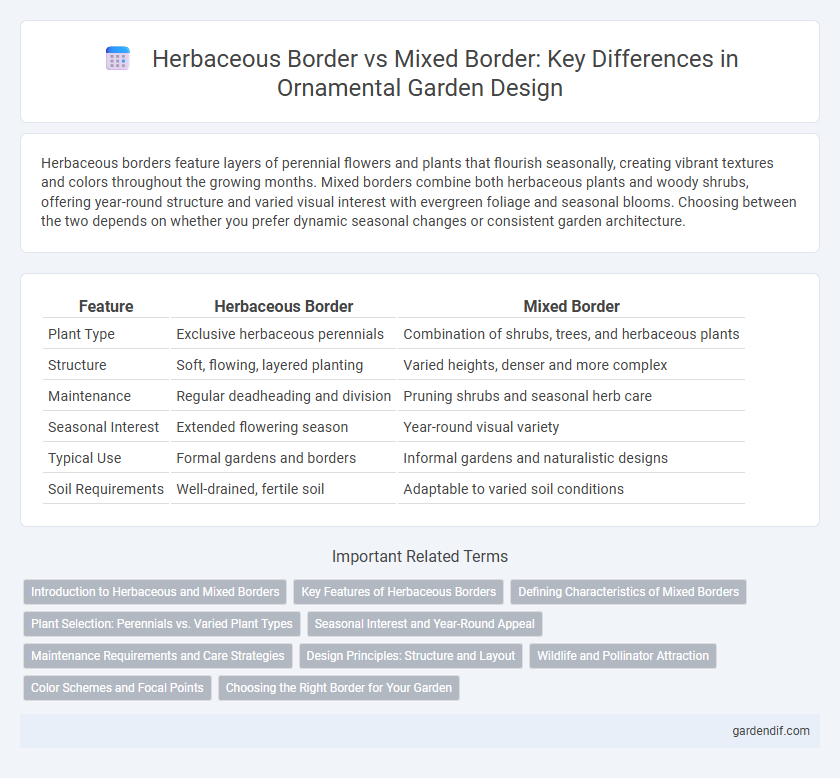
Herbaceous Border vs Mixed Border Illustration
Herbaceous borders feature layers of perennial flowers and plants that flourish seasonally, creating vibrant textures and colors throughout the growing months. Mixed borders combine both herbaceous plants and woody shrubs, offering year-round structure and varied visual interest with evergreen foliage and seasonal blooms. Choosing between the two depends on whether you prefer dynamic seasonal changes or consistent garden architecture.
Table of Comparison
| Feature | Herbaceous Border | Mixed Border |
|---|---|---|
| Plant Type | Exclusive herbaceous perennials | Combination of shrubs, trees, and herbaceous plants |
| Structure | Soft, flowing, layered planting | Varied heights, denser and more complex |
| Maintenance | Regular deadheading and division | Pruning shrubs and seasonal herb care |
| Seasonal Interest | Extended flowering season | Year-round visual variety |
| Typical Use | Formal gardens and borders | Informal gardens and naturalistic designs |
| Soil Requirements | Well-drained, fertile soil | Adaptable to varied soil conditions |
Introduction to Herbaceous and Mixed Borders
Herbaceous borders primarily feature non-woody perennial plants that provide vibrant seasonal color and dynamic textures, thriving in well-drained soil with adequate sunlight. Mixed borders combine herbaceous perennials with shrubs and small trees, offering layered structure and year-round interest through diverse plant heights and foliage types. Gardeners select herbaceous borders for vivid floral displays, while mixed borders enhance depth and complexity in ornamental garden design.
Key Features of Herbaceous Borders
Herbaceous borders showcase a dense planting of perennial flowering plants, providing vibrant seasonal color and structural variety without woody stems. They require careful selection of species based on bloom time, height, and foliage to maintain visual interest throughout the growing season. This type of border emphasizes plant texture and layering, creating a naturalistic yet refined ornamental display.
Defining Characteristics of Mixed Borders
Mixed borders combine both herbaceous perennials and woody shrubs, creating layered textures and year-round interest in ornamental gardening. These borders emphasize plant diversity with varying heights, foliage types, and seasonal blooms to enhance visual complexity and structure. Gardeners choose mixed borders to achieve a balanced blend of form and color that evolves through different growth stages.
Plant Selection: Perennials vs. Varied Plant Types
Herbaceous borders primarily feature perennials, chosen for their seasonal blooms, consistent growth habits, and ability to create layered textures throughout the year. Mixed borders incorporate a broader variety of plant types, including shrubs, evergreens, and annuals, offering diverse foliage, height contrasts, and year-round interest. Selecting plants in herbaceous borders emphasizes longevity and bloom cycles, while mixed borders prioritize structural variety and multi-seasonal appeal.
Seasonal Interest and Year-Round Appeal
Herbaceous borders consist primarily of perennial plants that provide continuous seasonal interest through varied bloom times and foliage changes, creating dynamic visual appeal from spring to autumn. Mixed borders combine shrubs, trees, and herbaceous plants to ensure year-round appeal by integrating evergreen structures and late-season berries with vibrant seasonal flowers. This combination enhances the garden's depth and texture, maintaining aesthetic value throughout all seasons.
Maintenance Requirements and Care Strategies
Herbaceous borders require regular pruning, deadheading, and seasonal cutbacks to maintain vibrant blooms and prevent overcrowding, demanding consistent attention throughout the growing season. Mixed borders combine shrubs, perennials, and annuals, necessitating diverse care strategies such as selective pruning, mulching, and pest management tailored to each plant type's specific needs. Effective maintenance of mixed borders involves balancing moisture levels and soil fertility to support varied root systems, ensuring overall garden health and aesthetic appeal.
Design Principles: Structure and Layout
Herbaceous borders emphasize a harmonious structure with layered planting that showcases perennials in rhythmic repetition, creating cohesive flows of color and texture throughout the season. Mixed borders integrate shrubs, climbers, and perennials, offering varied heights and forms that enhance spatial depth and provide year-round interest. Strategic layout in both designs balances symmetry and asymmetry for visual stability while allowing dynamic focal points that guide the viewer's eye through the landscape.
Wildlife and Pollinator Attraction
Herbaceous borders are densely planted with perennial flowering plants that provide continuous nectar sources, making them highly effective for attracting pollinators such as bees and butterflies. Mixed borders incorporate shrubs, trees, and herbaceous plants, offering diverse habitats and shelter for a wider range of wildlife, including birds and beneficial insects. Both border types support biodiversity, but mixed borders create multi-layered environments that enhance ecological complexity and sustain pollinator health more robustly.
Color Schemes and Focal Points
Herbaceous borders feature a cohesive color scheme, often using complementary or analogous colors to create a harmonious visual flow, while mixed borders combine shrubs, perennials, and annuals for varied textures and dynamic focal points throughout the seasons. The color schemes in herbaceous borders emphasize continuity and rhythm, supporting a unified garden aesthetic, whereas mixed borders allow for bold contrasts and unexpected focal highlights due to the variety of plant forms and flowering times. Focal points in herbaceous borders are usually created by groupings of plants with similar bloom colors, whereas mixed borders use architectural shrubs and standout perennials to anchor the design and draw the eye.
Choosing the Right Border for Your Garden
Herbaceous borders feature a continuous display of flowering perennials that provide seasonal color and textural variety, making them ideal for gardeners seeking a low-maintenance yet vibrant garden edge. Mixed borders combine shrubs, herbaceous plants, and sometimes small trees, offering year-round interest through varied plant heights, foliage, and bloom times, suitable for creating a dynamic, multi-dimensional landscape. Selecting the right border depends on garden size, maintenance preference, and desired visual impact, with herbaceous borders favoring concentrated floral displays and mixed borders delivering structural diversity.
Herbaceous Border vs Mixed Border Infographic

 gardendif.com
gardendif.com